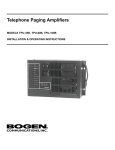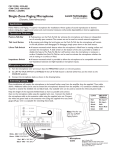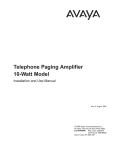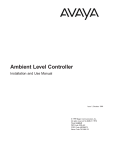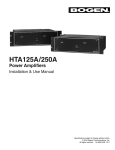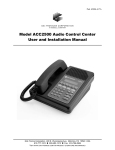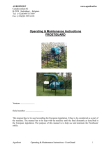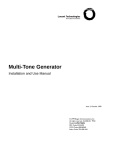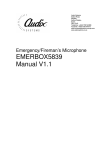Download Avaya 100-Watt Installation and Use Manual
Transcript
Telephone Paging Amplifier 35- and 100-Watt Models Installation and Use Manual Issue 1, October 1999 © 1999 Bogen Communications, Inc. All rights reserved. 54-2019-01 9910 LU35WAMP: PEC Code: 5328-035 COM Code: 408186070 LU100WAMP: PEC Code: 5328-101 COM Code: 408186088 Select Code: 701-000-100 © 1999 Bogen Communications, Inc. All Rights Reserved. Printed in Korea. Notice Every effort was made to ensure that the information in this guide was complete and accurate at the time of printing. However, information is subject to change. Important Safety Information Always follow these basic safety precautions when installing and using the unit: 1. Read and understand all instructions. 2. Follow all warnings and instructions marked on the product. 3. DO NOT block or cover the ventilation slots and openings. They prevent the product from overheating. DO NOT place the product in a separate enclosure or cabinet, unless proper ventilation is provided. 4. Never spill liquid on the product or drop objects into the ventilation slots and openings. Doing so may result in serious damage to the components. 5. Repair or service must be performed by a factory authorized repair facility. 6. The product is provided with a UL-CSA approved, 3-wire ground type plug. This is a safety feature. DO NOT defeat the safety purpose of the grounding type plug. DO NOT staple or otherwise attach the AC power supply cord to building surfaces. 7. DO NOT use the product near water or in a wet or damp place (such as a wet basement). 8. DO NOT use extension cords.The product must be installed within 6 feet of a grounded outlet receptacle. 9. DO NOT install telephone wiring during a lightning storm. 10. DO NOT install telephone jacks in a wet location unless the jack is specifically designed for wet locations. 11. Never touch uninsulated wires or terminals, unless the line has been disconnected at the paging or controller interface. 12. Use caution when installing or modifying paging or control lines. Support Information Paging systems integrated with small phone systems such as Merlin Legend and Partner are supported by the National Service Assistance Center (NSAC). The main number for the NSAC is 800-628-2888. Paging systems integrated with large switches such as the DEFINITY G3 are supported by the Technical Service Center (TSC). The main number for the TSC is 800-242-2121. Trademarks Aphex Aural Exciter is a registered trademark of Aphex Systems, Ltd. Domestic and International Approvals UL Listed E15903. Page 2 of 12 Contents Page INTRODUCTION ..........................................................................................................................4 PACKAGE CONTENTS..............................................................................................................4 INSTALLATION..............................................................................................................................5 Mounting ............................................................................................................................5 Wall Mounting ....................................................................................................................................5 Rack Mounting ..................................................................................................................................5 WIRING CONNECTIONS ........................................................................................................6 Input Wiring......................................................................................................................6 TEL Input and Control Pair ............................................................................................................6 Music Input..........................................................................................................................................7 Microphone Input ..............................................................................................................................7 Night Ringer Connections ................................................................................................................8 Bridging Inputs....................................................................................................................................8 Input Cover Replacement ................................................................................................................8 ‘ Output Wiring ................................................................................................................9 Speaker Connections ........................................................................................................................9 LUWMT1A Connector ..................................................................................................................10 Output Cover Replacement..........................................................................................................10 OPERATION ..................................................................................................................................11 Indicators ..................................................................................................................11-12 Page 3 of 12 Telephone Paging Amplifier POWER PEAK LEVEL APHEX TREBLE BASS RINGER VOLUME MUSIC MUTE MUSIC VOLUME MIC VOLUME AMPLIFIER TEL VOLUME ALC BRIDGING MUSIC IN TEL CONTROLS COM MIC MIC BAL GND + TEL BAL T R CONTACT RING TEL RING Figure 1: Telephone Paging Amplifier Introduction This document describes the Lucent 35- and 100-watt Telephone Paging Amplifiers. These are full-featured, wall-mounted amplifiers which provide inputs for dry loop 600-ohm telephone page signal, background music source, and low impedance microphone. A set of control inputs allow an external contact closure to mute background music and open the telephone page channel. Background music mute level during page is adjustable and the music slowly fades back in after the page is completed. An automatic level control system limits the output level of the telephone page channel so that differences in the volume of the paging party's voice will be less noticeable. Bass and treble controls are provided for adjusting the quality of the output signal. An Aphex® Aural Exciter feature is also provided. Aphex improves the clarity of the output signal by replacing the higher frequency harmonics that are normally lost through the telephone system.This amplifier includes a builtin night ringer that can be triggered by either a standard telephone (analog) ring signal or an external contact closure. The night ringer mutes the background music, but not pages. Package Contents * Telephone Paging Amplifier unit * Pair of Rack Mount Brackets * 8 mounting screws * Installation and Use Manual Before You Start Review the contents of the box. Read through this entire manual to understand how this product installs and operates. NOTE: Be sure you have enough 22 AWG shielded, twisted pair wire (COM Code: 401882956, PEC Code: 2734-SPK) for your speaker runs. Page 4 of 12 Figure 2: Mounting the Amplifier SCREW 1/2" TRUSS-HEAD PO WE R L LE AK VE PE X AP TR HE EB BA LE SS ER RING S MU IC ME LU VO MU ME LU VO SIC MU MIC TE VO LV LU OLU .... .... .... .... . .... .... TE .... .... .... .... .... ME ME ALC RACK MOUNTING SCREWS ARE NOT SUPPLIED Installation Mounting The amplifier is designed for wall mount applications but can also be mounted in a standard 19" rack using the included rack adapter brackets. The 35W amplifier weighs 16 lbs. and the 100W amplifier weighs 21 lbs. NOTE: The amplifier will produce heat during operation which will rise and may cause problems for temperature-sensitive equipment mounted above it. Mount the amplifier near the top of the backboard (for wall mounting) or rack (for rack mounting) so that no other equipment will be above it. If this is not possible, then allow at least 12" between the top of the amplifier and the bottom of any equipment positioned above it. Also allow at least 4" between the bottom of the amplifier and any equipment below it to allow for adequate air circulation. Wall Mounting To wall mount this unit, use the four 5/8” pan head screws with nylon washers provided (see Figure 2).The screws should protrude approximately ¼" from the surface of the backboard. Lift the amplifier and place it over the 4 screws using the keyhole slots in the flanges at the sides of the amplifier.The screws should engage the keyhole slots. Once in the keyhole slots, tighten the screws to secure the amplifier. Rack Mounting To mount the amplifier in a 19" rack, it is first necessary to attach the rack adapter brackets to the amplifier flanges (see Figure 2). Start the four ½" truss-head selftapping screws into the 2 small round holes in each of the adapter brackets. Be certain to secure the screws from the correct side of the brackets.The brackets should mirror each other so that they can be installed on opposite sides of the amplifier. From behind the amplifier, slip the rack adapter, with screws, through the opening in the keyhole slots and slide them up in to the keyhole slots.Tighten the screws securely. Lift the amplifier up to the front of the rack and secure it to the rack with the necessary screws (not included). The amplifier will protrude out from the front of the rack. Page 5 of 12 Wiring Connections IMPORTANT: Before making any connections or wiring changes to the amplifier or any equipment connected to the amplifier, make sure that the amplifier is NOT plugged into an AC outlet. NOTE: The amplifier does not have a power switch, so it must be unplugged in order to turn the power off. Input Wiring All signal input and control wiring is made to the terminal strip and RCA connectors beneath the left side access cover. Loosen the 2 Phillips-head screws on each side of the cover and remove it. TEL Input and Control Pair The telephone input is a 600-ohm, dry loop, balanced input. It is controlled by a dry contact closure that is made between the control terminals labeled TEL and COM. Shorting these terminals together will mute the background music input and open the Tel page channel (see Figure 3). NOTE: In instances where the amplifier is to be placed permanently in the Tel page mode, a wire jumper must be installed between the TEL and COM terminals. Telephone Paging Amplifier Figure 3: Wiring for TEL Input MIC VOLUME TEL VOLUME ALC TEL CONTROLS COM MIC Universal Paging Access Module BGM IN MODE OFF 24VDC PWR SUPPLY 48VDC PWR SUPPLY CONFIRMATION TONE PREANNOUNCE TONE VOX DISABLE VOX ENABLE S1,S2 S3 S4 S5 ON S1,S2 PHONE SYSTEM S4 S3 EXT VOX ENABLE PAGING OUTPUT S5 CONTACT CLOSURE A PAGE PORT INPUT POWER SUPPLY (TRUNK ACCESS ONLY) T R +M -M PT PR N.O. COM +24/48 -24/48 (0.1A) MIN MAX TONE VOL. MIN MAX VOX DELAY MIN MAX PAGING TIME MODE SWITCHES BGM VOL CONTACT CLOSURE B N.O. COM Page 6 of 12 BRIDGING MUSIC IN APHEX MIC BAL + GND TEL BAL T R CONTACT RING TEL RING T R Tel Input to Universal Coupler After properly connecting your Universal Coupler (909) to your Auxiliary Trunk port, set your switches as follows: C1/C2 to C2; Rocker Switch 3 closed; and all others open. Coming out of the J2 Jack of the Coupler, connect the blue/white pair to the amplifier Tip and Ring. Connect the brown/white pair to Tel and Com on the control terminals. Music Input A single RCA connector is provided for the connection of a background music source. Use a male RCA-to-RCA cable (not included) to make this connection. This is a mono input and requires that the output of stereo sources be converted to mono by using a Y-adapter (not included). Use a LUWMT1A to balance the music input, if necessary, to reduce hum/noise from a grounded music source. Microphone Input A high gain, low impedance microphone input is provided in this amplifier. It is designed to work with microphone LUSZMIC (Com Code: 408186238, PEC Code: 5335-400). Connect the microphone's black wire to the amplifier's "-" (negative) terminal under the MIC BAL connections. Connect the microphone’s Red wire to the "+" (positive) terminal. Connect the shield wire from the microphone to the adjacent GND terminal. Connect the microphone's white lead to the Control terminal marked MIC and the green lead to the COM. (See Figure 4.) Two conductor shielded microphone wire should be used to extend the cable from the microphone. 22 AWG shielded, twisted pair speaker cable (Com Code: 401882956, PEC Code: 2734-SPK) will also work. When extending microphone cable, be sure to connect the shields of the microphone cable to the extension wire. Figure 4: Connect Microphone to Telephone Paging Amplifier MIC VOLUME TEL VOLUME ALC MUSIC IN APHEX TEL CONTROLS COM MIC MIC BAL + GND BRIDGING TEL BAL T R CONTACT RING T TEL RING R K C LO Shield - GND White - MIC ‘CONTROLS’ Green - COM ‘CONTROLS’ Microphone Cable Red - MIC + ‘MIC BAL’ Black - MIC - ‘MIC BAL’ Page 7 of 12 Night Ringer Connection Either a standard telephone (analog) ring signal (90 - 105 V AC, 20 - 30 Hz) or an external contact closure activates the night ringer function of the amplifier. To activate the night ringer using standard telephone (analog) ring, connect the analog station's tip lead to the TEL RING "T" terminal and connect the ring lead to the "R" terminal. If using an external contact closure, connect the closure pair across the CONTACT RING terminals (not polarized).The night ringer follows the cadence of the activating signal. Bridging Inputs Bridging increases the total output power of the system. For example, when two 100-watt amplifiers are bridged, the total output capacity is 200 watts. Bridging is also a means by which to increase the number of amplifier inputs to an amplifier by using the input stage of a second amplifier (see Figure 5).The inputs of two or more amplifiers can be combined by using the bridging connections provided on these amplifiers.An RCA-to-RCA cable (not included) is used to connect the bridging jacks of different amplifiers together. Once bridged, each amplifier will amplify the inputs present on both amplifiers.The level control of a particular input on an amplifier will control the volume of this signal on both amplifiers. The cable used to bridge amplifiers should not exceed 20 feet in length. NOTE: You can only bridge up to 3 amplifiers at one time. Input Cover Replacement When all connections are made, remove an appropriate knockout on the input cover. Replace the cover and tighten the screws while dressing the wires through the knockout hole. MIC VOLUME TEL VOLUME POWER ALC PEAK LEVEL APHEX TREBLE BRIDGING MUSIC IN APHEX BASS RINGER VOLUME TEL MIC BAL CONTROLS COM MIC TEL BAL GND T + CONTACT RING R T TEL RING MUSIC MUTE R MUSIC VOLUME MIC VOLUME AMPLIFIER TEL VOLUME ALC BRIDGING MUSIC IN TEL CONTROLS COM MIC MIC BAL GND + TEL BAL T CONTACT RING R TEL RING POWER MIC VOLUME PEAK LEVEL APHEX TREBLE TEL VOLUME BASS ALC RINGER VOLUME MUSIC MUTE MUSIC VOLUME BRIDGING MUSIC IN APHEX MIC VOLUME AMPLIFIER TEL VOLUME ALC TEL CONTROLS COM MIC MIC BAL + GND TEL BAL T R CONTACT RING TEL RING T BRIDGING MUSIC IN R TEL CONTROLS COM MIC MIC BAL + GND TEL BAL T R CONTACT RING TEL RING Figure 5: Bridging Inputs Page 8 of 12 Output Wiring All output wiring connections are made to the terminal strip located under the right side access panel. Loosen the 2 Phillips-head screws on each side of the cover and remove the cover. IMPORTANT: Before making any connections or wiring changes to the amplifier or any equipment connected to the amplifier, make sure that the amplifier is NOT plugged into an AC outlet. NOTE: The amplifier does not have a power switch, so it must be unplugged in order to turn the power off. Speaker Connection 70-volt speaker connections are made between the 70V and COM terminals on the output terminal strip (see Figure 6). Use a 22 AWG shielded, twisted pair cable (Com Code: 401882956, Pec Code: 2734-SPK). Connect the shield of the cable to the GND terminal of the output terminal strip. The COM and GND Terminals of the output terminal strip are connected using a shorting clip. The shorting clip enables the amplifier output to act as an unbalanced output (one side of the output connected to ground). If desired, the output can be made to be a balanced output with no connection to ground. To balance the output, simply remove the shorting clip. All speaker connections remain the same as above including connecting the shield to the GND terminal. NOTE: The amplifier output terminal strip also includes terminals for 16-ohm, 25V and 25VCT speaker connections. These are provided for special applications and are generally not used. CLASS 2 WIRING ACCEPTABLE 16 25V 25VCT COM GND _ 70V + RINGER VOLUME MUSIC MUTE MUSIC VOLUME MIC VOLUME AMPLIFIER TEL VOLUME ALC BRIDGING MUSIC IN CONTROLS COM MIC MIC BAL + GND TEL BAL T R CONTACT RING TEL RING _ TEL + Figure 6: Speaker Connection, Output Wiring Page 9 of 12 Figure 7 : LUWMT1A Connection to RCA Jack on Amplifier RCA Jack . .... ABLE ..... EPT CC G A ..... IRIN 2 W ... SS .. CLA . .... T-..A WM . .... LUWMT1A Amplifier LUWMT1A Connector An RCA jack is provided near the output terminal strip for connection to an LUWMT1A impedance matching transformer (Com Code 405891680). A 600-ohm, telephone level output signal can be obtained by plugging the RCA connector of the LUWMT1A into this jack and taking the output signal off of the LUWMT1A screw terminals. (See Figure 7.) NOTE: For information on connecting Telephone Paging Amplifiers to the Lucent PCM Paging System Zone Controller (model LUPCM), please refer to the LUPCM instruction manual. Output Cover Replacement When all output connections are made, remove the appropriate knockout on the input cover. Replace the cover and tighten the screws while dressing the wires through the knockout hole. Page 10 of 12 Operation IMPORTANT: Before plugging the amplifier into an AC outlet, turn all volume controls to their full counterclockwise positions and all other controls to their reference position or to mid rotation. Indicators POWER IND The POWER IND LED illuminates whenever AC power is applied to the amplifier (there is no power switch on the amplifier). PEAK LEVEL The PEAK LEVEL LED illuminates whenever the speaker output signal level approaches its maximum level. This indicator is used when setting volume levels. Maximum output level is achieved when the PEAK LEVEL indicator flashes intermittently on loud peaks of the input signal. If the indicator illuminates steadily, the output signal volume is set too high and distortion is occurring. Decrease the volume control for the appropriate input until the indicator flashes only occassionally. TEL VOLUME This control adjusts the level of the telephone page output. A reference level setting position is provided with this control. When set to this position, the output level of the page should be about maximum. Further adjustment can be made using the PEAK LEVEL indicator described above. ALC The ALC controls the level at which the amplifier will begin to limit the output signal level. A reference setting position is provided for this control. Normally, the reference position provides optimum performance; however, if further adjustment is desired, use the following steps for setting the ALC control. Manual Output Adjustment Procedure (follow only if minor adjustments to the reference settings are not adequate) 1) Disable ALC by turning ALC control. 2) Make a page, speaking softly, yet distinctly. Set the TEL VOLUME control to the desired paging level during this page. 3) Make another page speaking relatively loudly this time. Rotate the ALC control, while making the page, until it has the same loudness as the first page. NOTE: The TEL Volume and ALC controls work together to set the output level. When both controls are set to the reference positions, the amplifier provides a nominal 70V signal output (optimum). NOTE: The PEAK LEVEL indicator should not show excessive peaking during loud pages. If this is occurring, the ALC control must be further increased. Page 11 of 12 MUSIC VOLUME This control adjusts the level of the background music output. No reference level setting position is provided. The background music level should be set to an acceptable level without overdriving the system. When adjusting this level, the PEAK LEVEL indicator should be observed to ensure that the amplifier signal is not distorted. MUSIC MUTE This control adjusts the level of the background music heard during a paging announcement. No reference level setting position is provided. The background music mute level should be set to the customer's satisfaction, but the page announcement must always be easily heard above the background music. MIC VOLUME This control adjusts the level of the microphone page output. A reference level setting position is provided with this control. When set to this position, the output level of the page should be about maximum. Further adjustment can be made by observing the PEAK LEVEL indicator. CAUTION: Microphone should not be placed near any paging loudspeakers. RINGER VOLUME This control adjusts the level of the night ringer tone output. No reference level setting position is provided. The background music level should be set to the customer's satisfaction. When adjusting this level, the PEAK LEVEL indicator should be used to ensure that the amplifier signal is not distorted. APHEX This control adjusts the amount of Aphex® Aural Exciter effect mixed in to the page signal. No reference position is provided for this feature. To use this function, the APHEX switch beneath the input connection cover must be set to ON. Setting this switch to OFF bypasses the Aphex effect and makes the control inoperable.With the APHEX switch turned on, make a page and rotate the control until the audio sounds crisp and clear. BASS and TREBLE Bass and treble controls are provided to adjust the high frequency and low frequency response of the paging system. Reference positions are provided for these controls. When set to these positions, the frequency response of the system will be flat. Set the controls to the customer’s satisfaction. Clockwise rotation increases (boosts) the response and counterclockwise reduces (cuts) the response. Increasing bass and/or treble can cause output signal peaks to increase. Check the PEAK LEVEL indicator after making bass adjustment and lower the music input volume if excess peaking occurs. Page 12 of 12












